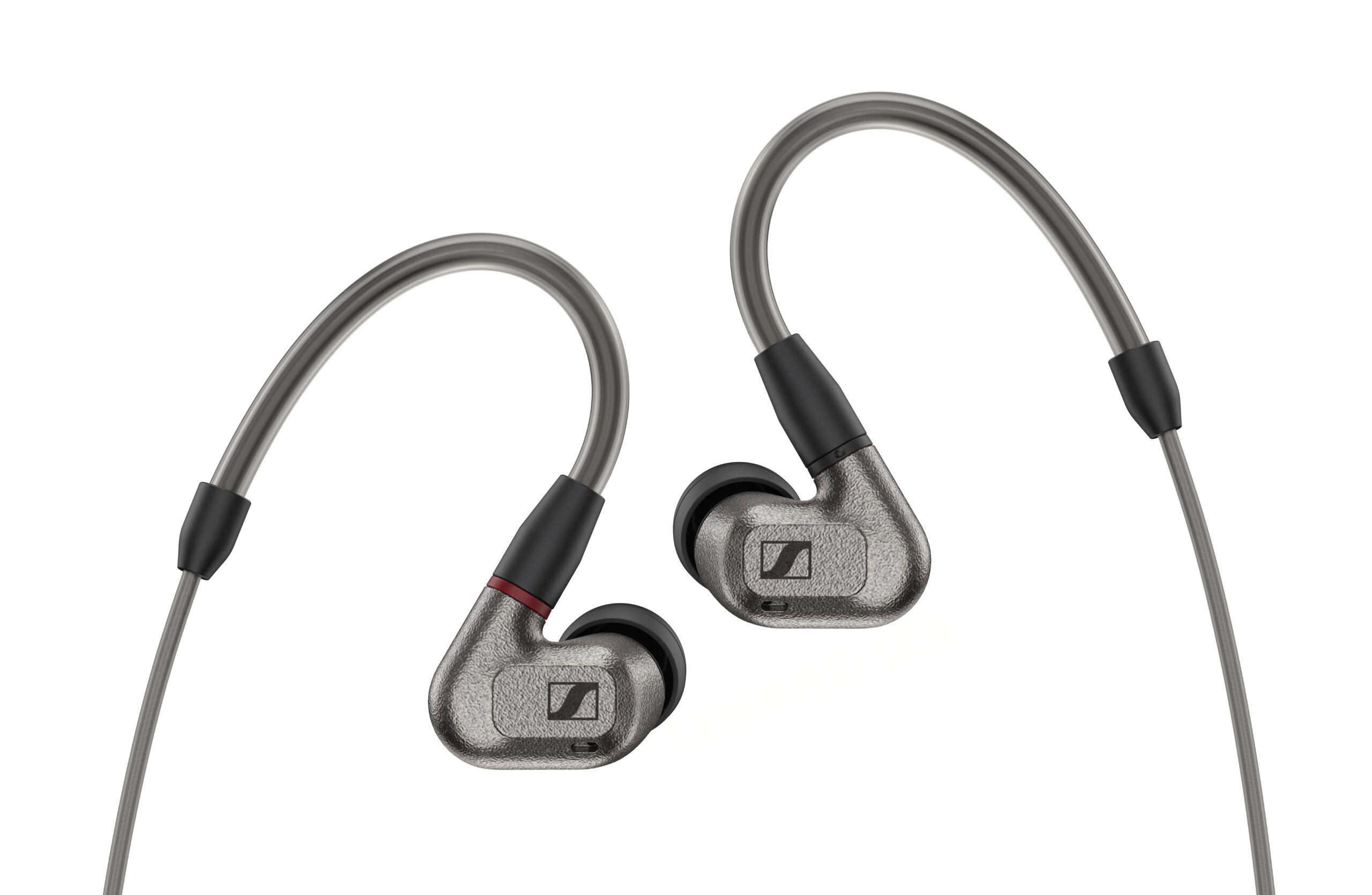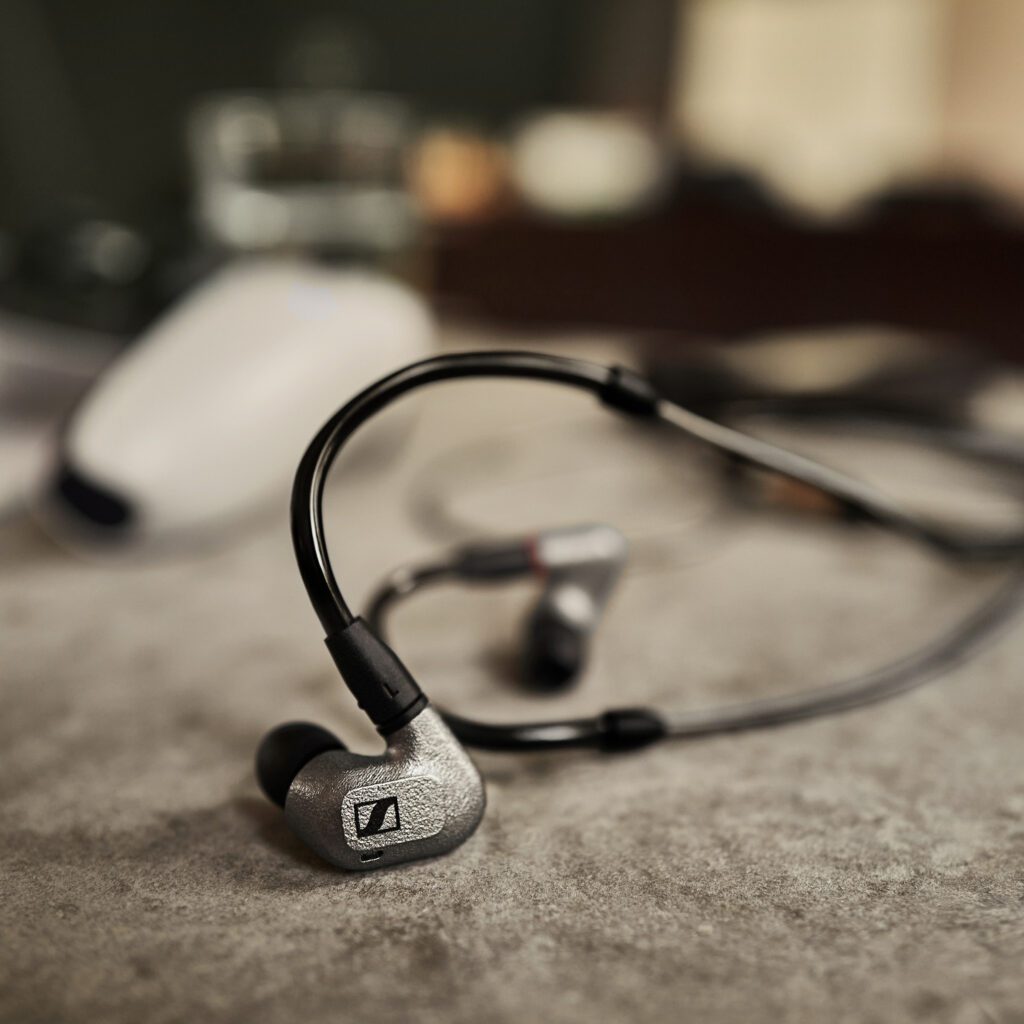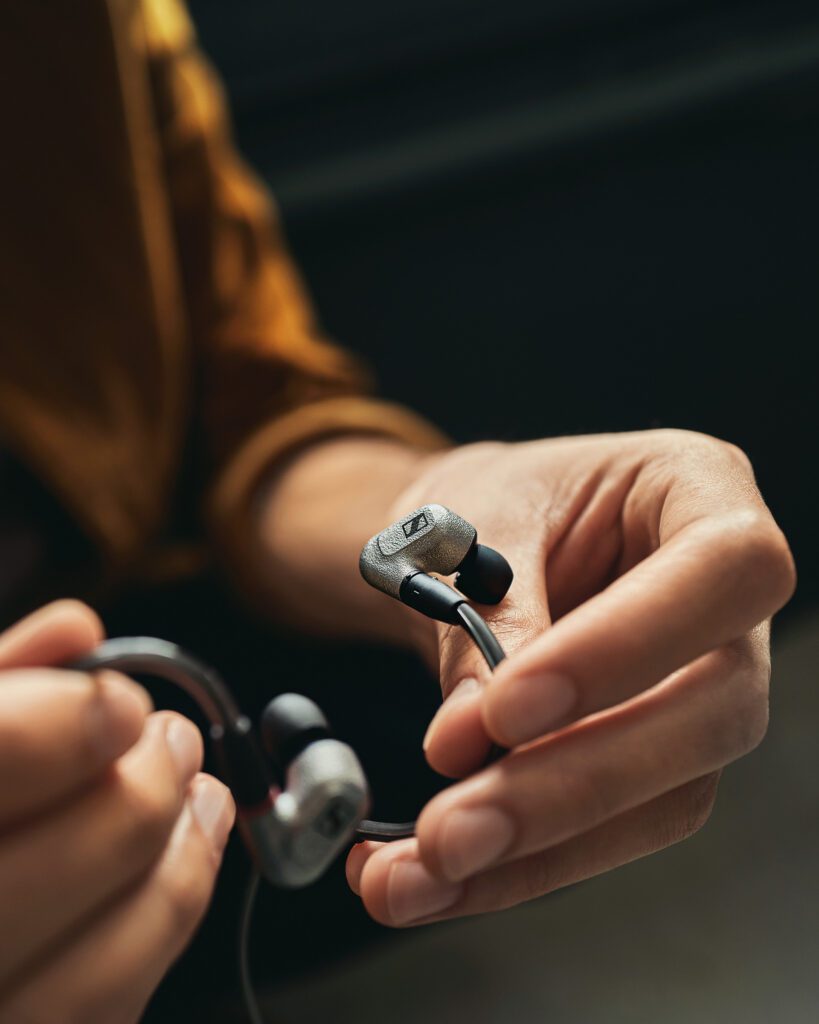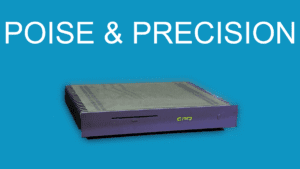
“Fashion is ephemeral, dangerous and unfair.” Admittedly Karl Lagerfeld didn’t have the world of consumer electronics uppermost in his mind when he made this statement, but it nevertheless applies. Sennheiser certainly seems to think so.
As of right now, it’s hard to think of a less fashionable sector of the hi-fi market than that of wired in-ear monitors. Mainstream consumers gave up on them a while ago – at almost exactly the same time as smartphone manufacturers gave up on headphone sockets, in fact. You might be forgiven for thinking wired headphones are the preserve of airlines who want you to enjoy the in-flight ‘entertainment’ but don’t want you to be tempted to make off with their headphones after landing.
Wired beats wireless
Those who take listening seriously, though, know that for sound quality a wired connection beats the wireless equivalent 99 times out of 100. These are the people who know a portable digital audio player wipes the floor, where sound quality is concerned, with even the most capable and least compromised smartphone. And these are the people Sennheiser has squarely in its sights with the IE600 wired in-ear monitors.

As with its IE900 wired in-ear monitors we reviewed back in issue 197, Sennheiser intends the IE600 to deliver a superior on-the-go listening experience. Unlike the IE900, though, the IE600 are merely very expensive rather than eye-wateringly pricey.
But despite what Sennheiser would no doubt describe as a ‘affordable’ price, there’s next-to-no evidence of corners being cut or pennies being pinched. The IE600 may be necessarily small, but they’re very big indeed on specification.
TrueResponse
Inside each tiny, lightweight (4g) housing, Sennheiser has found room for a 7mm ‘TrueResponse’ transducer to do the audio business. The company is adamant that a single, full-range driver is preferable to the multiple-driver-plus-balanced-armature alternative many self-proclaimed ‘high-end’ alternative designs utilise – as long as it’s properly implemented, that is. Given that Sennheiser is claiming a frequency response of 4Hz to very nearly 47kHz, its assertion that the driver fitted here is ‘full range’ seems difficult in the extreme to argue with. And given that Sennheiser is claiming the most accurate channel-matching and the lowest unit-to-unit variations anywhere in the industry for its drivers, thanks to a manufacturing operation that includes precision cameras to monitor the process, ‘properly implemented’ seems to be covered too.
Also inside each earpiece is Sennheiser’s ‘D2CA’ technology. In layman’s terms (which are, let’s face it, the terms with which we’re all most comfortable), there are two tuned resonator chambers inside the nozzle of each IE600 – they’re designed to mitigate the ‘masking’ effect that can manifest itself at lower volumes. When similar sounds occur simultaneously in a piece, it’s tricky for human hearing to resolve – so D2CA captures and attenuates these frequencies, allowing uncolored and naturalistic reproduction. The non-layman’s explanation is way too long to go into here.
3D Printed
The earbuds themselves are the result of engineering that’s no less involved and no more compromised than that of what’s inside them. The housing is formed using metal-powder-based 3D printing, meaning all necessary chambers and channels are created with no milling required. And the zirconium alloy from which they’re formed has triple the strength and flex-resistance of (suddenly antiquated) high-performance steel – it features in the drilling head of NASA’s Mars Rover, which bodes well for its chances of standing up to a stint in the departure lounge followed by a long-haul flight. After a thorough cleaning, steel-shot blasting, polishing and surface treatment (this last, admittedly, in the name of aesthetic appeal only), the housing is complete and ready to resist corrosion and scratches no matter how careless the eventual owner.

The IE600 are supplied with a couple of paramid-reinforced cables – one’s an unbalanced cable with a 3.5mm termination and the other a balanced 4.4mm alternative. They connect to the earbuds using gold-plated MMCX (micro miniature coaxial) connections that are recessed into the housing for optimum stability. The cables themselves have integrated, flexible and pliant earhooks to help achieve a comfortable fit – and Sennheiser provides six pairs of eartips (three foam, three silicone) to the same end. A hard, compact carry-case and a rather self-important ‘certificate of authenticity’ complete the package.
Painstaking engineering
In order to do some justice to this overtly painstaking engineering, the IE600 are connected to both the 4.4mm output of an iFi iDSD Diablo DAC/headphone amp attached to a 2020 Apple MacBook Pro and and the 3.5mm output of an EarMen TR-Amp DAC/headphone amp linked to the same laptop – though not at the same time, obviously. Surely no one is going to drop £600 on a pair of in-ear monitors and then just hook them straight into the headphone socket of their computer, after all. Are they?
And then to double down on all the high-end high-quality good taste that this listening session seems to be all about, the first listen is to a DSD64 (5644.8kbps) file of Stevie Wonder’s mighty Living for the City [Tamla]. The results are predictable, but no less enjoyable and engrossing for it.

The sound of the Sennheiser IE600 is absolutely saturated in detail – it drips from every element of the recording, no matter how minor or how deeply buried in the mix. The soundstage the Sennheiser establish is prodigiously broad, absolutely rock-solid in the way it’s focused, and so cleanly separated that no facet of the recording can’t be located and individualised. No transient is too short-lived to escape the attention of the IE600, and the powers of organisation on display here are such that the unity and coherence of the overall performance isn’t so much hinted at as made blindingly obvious.
Remarkable Extension
Down at the bottom of the frequency range there’s remarkable extension – perhaps not down to the 4Hz Sennheiser is claiming, but certainly the low frequencies dig down to a level where no sunlight can reach them. To complement this prodigious depth, bass sounds are fanatically straight-edged, attacking and decaying with absolute certainty – when the left hand reaches down to the far end of the clavinet’s keyboard, the alacrity of the IE600 response is almost startling. As with the rest of the frequency range, the Sennheiser give the low stuff all the detail (of tone, of texture, of timbre) to make every note an individual occurrence – and they have the dynamic potency to differentiate one key-strike from the next with real positivity.
The midrange, though, is the star of this recording – very few singers push their voice as far forward in the mix as Stevie Wonder, but then very few singers have the purity and character of tone to get away with it. The IE600 are alive to the tiny contributions made by inhalation and palate noise, and consequently build a vocal performance that’s thrilling in its immediacy.
The spaces, silences and pauses for breath apparent throughout the recording are all given due consideration too, and even though this song is generously overdubbed the IE600 present it as a lucid and consolidated whole. Only the top of the frequency range, which extends as gratifyingly far as it does at the other end, sounds the mildest of alarms – there’s an almost subliminal edginess to the way the Sennheiser serve up treble sounds. As far as this recording is concerned, the shine and wolfish bite aren’t problematic – but give the IE600 a toothy recording or attach them to an unsympathetic source of music and they could be.
Power Struggle
And there are, it turns out, limits to these monitors’ powers of resolution. ‘Girls in Their Summer Clothes’ by Bruce Springsteen [Columbia] is a narrow, congested pea-souper of a recording, with competing elements piled on top of each other – and despite their best efforts, the IE600 can’t open it up or spread it out. The listener can almost sense a power struggle going on, as the monitors attempt to force some distance between the horns, the percussion, the piano and the voice. Still, that’s more about the recording than the Sennheiser IE600.
Having enough money to buy premium in-ear monitors and attach them to a high-quality audio player doesn’t automatically mean you only listen to glossy, high-fidelity recordings, of course. But as long as you’re aware of the limitations of the IE600 where the silk purse/sow’s ear interface is concerned, there’s very little else that should dissuade you from trying them out.
Technical specifications
- Type in-ear monitor
- Drivers 7mm dynamic driver
- Frequency Response 4Hz–46.5kHz
- Impedance 18 Ohms
- Noise cancellation none
- Distortion < 0.06% at94dB / 1kHz
- Sensitivity not quoted
- Accessories 6 × silicon/foam eartips; hard case; MMCX‑terminated 2.5mm and 3.5mm cables
- Weight 4g
- Price £599
Manufacturer
Sennheiser
UK Distributor
Sennheiser
By Simon Lucas
More articles from this authorRead Next From Review
See all
PrimaLuna EVO 100 phono preamplifier
- Apr 22, 2024

Reiki Audio SuperSwitch Master Pro + Servant Pro
- Mar 27, 2024

Melco Audio N1-S38 music server
- Mar 27, 2024











